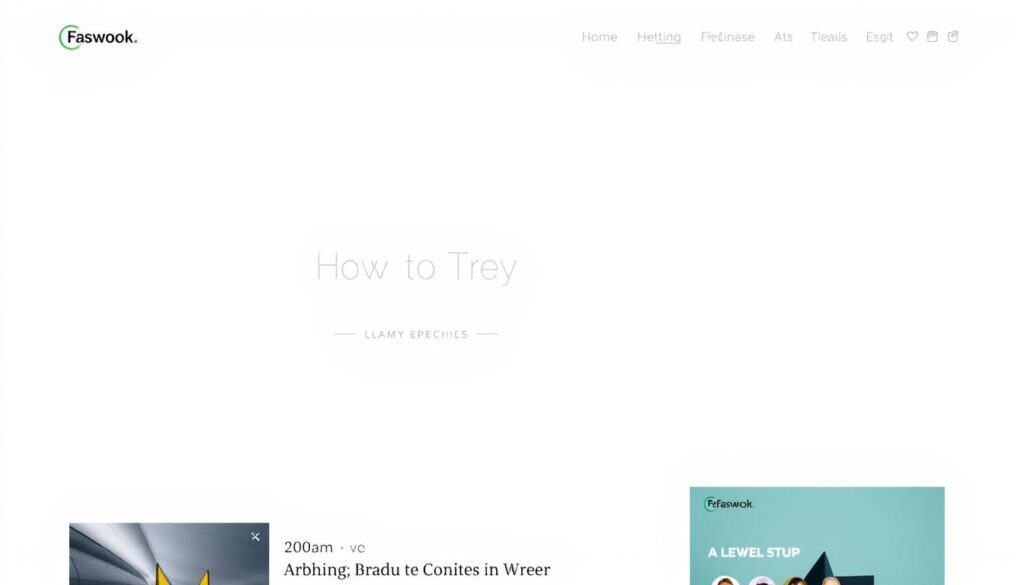“The future belongs to those who believe in the beauty of their dreams,” as Eleanor Roosevelt once said. Starting a blog in 2025 is not just about sharing your thoughts—it’s about building a strong online presence and unlocking monetization opportunities. Whether you’re 18 or 88, this guide is here to help you create a blog that stands out, even with basic computer skills.
In just 20 minutes, you can launch a beautiful blog using pictures and videos. Our step-by-step guide is designed for beginners, ensuring you can get started without any technical hassle. We’ll cover everything from choosing the perfect name to mastering SEO and promotion. Plus, you’ll gain insights from experienced bloggers who have already paved the way.
Ready to take the leap? This guide is your roadmap to success. Let’s dive in and make your blogging journey as smooth and rewarding as possible.
Key Takeaways
- Launch a blog in just 20 minutes with basic computer skills.
- Follow a step-by-step guide designed for beginners.
- Learn from experienced bloggers and gain practical insights.
- Discover how to create a strong online presence and monetize your blog.
- Explore the complete process, from choosing a name to SEO and promotion.
Understanding the Blogging Landscape in 2025
As we step into 2025, the world of blogging continues to evolve rapidly. With over 70% of internet users seeking information through blogs, the platform has become a cornerstone of online content. This shift underscores the importance of adapting to new trends and technologies to stay relevant.
Readers today expect more than just written content. They demand engaging, interactive experiences that cater to their needs. Blogs now serve as both personal diaries and professional platforms, blending storytelling with strategic marketing. This dual role highlights the versatility of blogging in the modern era.
Search engine optimization (SEO) plays a crucial role in making your blog visible. With Google dominating 92% of the search engine market, optimizing your content is essential. Fresh, high-quality posts not only attract organic traffic but also establish your authority in your niche.
Choosing the right platform can significantly impact your blog’s success. Whether you opt for WordPress, Medium, or another service, ensure it aligns with your long-term goals. A strong online presence, coupled with effective digital marketing, helps drive consistent traffic and fosters a loyal audience.
Understanding this evolving landscape is key to strategic planning. By focusing on content quality, design, and user experience, you can create a blog that stands out. Embrace these changes and position yourself for success in the dynamic world of 2025 blogging.
Selecting Your Niche and Crafting a Distinctive Blog Name
Choosing the right niche is the first step to creating a successful blog. Your niche should reflect your passions and interests, as it will make your content more engaging and authentic. A well-defined niche helps attract a dedicated audience and increases engagement rates by up to 50%.
When brainstorming your blog name, aim for something descriptive and memorable. A strong name can enhance your brand and attract the right audience. For example, using alliteration or portmanteaus can make your name catchier. Tools like domain name generators can help you find unique options.

Researching name availability is crucial. Ensure your name is easy to spell and pronounce, as this contributes to its success. Aligning your name with your long-term business goals will help you build a lasting brand. Remember, your blog name is more than just a title—it’s the foundation of your online identity.
Choosing the Perfect Domain Name for Your Blog
Your domain name is more than just an address—it’s the identity of your blog. It’s how readers find you and remember you. A good domain name can make your blog stand out and attract more visitors.
To find the perfect domain, start by using online tools to check availability. These tools can help you search for your desired name and suggest alternatives if it’s already taken. For example, if your first choice is unavailable, consider using a different extension like .net or .org.
Keep it simple and memorable. Avoid hyphens and double letters, as they can confuse readers. Shorter names (under 15 characters) are easier to remember and type. Also, make sure your domain is easy to spell to avoid losing traffic due to typos.
Once you’ve found the perfect name, secure it quickly. Use a reliable registration tool to complete the process. Don’t forget to check for additional extensions to protect your brand. Many bloggers also register their personal name as a domain for future flexibility.
Remember, your domain name is a long-term investment. Take your time to choose wisely, and click through recommended tools to find the ideal name for your blog. A well-chosen domain can boost your SEO and help you build a strong online presence.
Setting Up Web Hosting and Installing WordPress
Setting up reliable web hosting is a cornerstone of launching a successful blog. Web hosting serves as the backbone of your blog, providing the necessary storage and access to your content online.
Why Reliable Hosting Makes a Difference
Choosing a reputable hosting provider can significantly enhance your blog’s performance and security. A good hosting service ensures your website loads quickly, offers reliable uptime, and provides excellent customer support. For instance, BlueHost is a popular choice among bloggers as it offers a free domain, easy WordPress installation, and 24/7 support.
Step-by-Step WordPress Installation
Installing WordPress is straightforward with most hosting providers offering one-click installation tools. Here’s how you can get started:
- Register your domain and set up your hosting account.
- Use the one-click installer provided by your host to begin WordPress installation.
- Follow the prompts to configure your database and administrator account.
WordPress typically installs in under five minutes. Once installed, you can access your dashboard to customize themes, plugins, and start creating content.

Troubleshooting common installation issues, such as database errors, can often be resolved by resetting your MySQL password or ensuring proper PHP configuration. Using trusted tools and services helps avoid complications down the line.
Customizing Your Blog Design for Impact
Your blog’s design is more than just aesthetics—it’s a powerful tool to capture attention and keep readers engaged. In 2025, with so much content available, a well-designed blog can be your key differentiator. Let’s explore how to make your blog visually appealing and user-friendly.
Selecting a Responsive Theme
A responsive theme ensures your blog looks great on all devices, from smartphones to desktops. WordPress offers over 200 themes, many of which are free and easy to install. Themes like “Twenty Twenty-Five” are popular for their clean, modern look and responsiveness. To install a theme:
- Go to your WordPress dashboard.
- Navigate to Appearance > Themes.
- Browse or search for a theme you like.
- Preview and install it with one click.
Tweaking Design and Layout Options
Once you’ve chosen a theme, it’s time to personalize it. Use WordPress’s built-in customization tools to adjust layouts, colors, and fonts. These tools are user-friendly, so even without design experience, you can create a unique look. Small changes, like increasing font size for readability or adjusting spacing, can significantly enhance the user experience.
Consistency is key. Use the same style across all your posts to build credibility and make your blog recognizable. Experiment with different designs to find what works best for your audience. A well-designed blog not only attracts readers but also keeps them coming back.

Remember, your blog’s design is an extension of your brand. Take the time to make it reflect your personality and resonate with your community. With the right tools and a bit of creativity, you can create a blog that stands out in the crowd.
Creating Engaging and Authentic Blog Content
Content is the heartbeat of every successful blog. It’s what draws readers in and keeps them coming back. In 2025, with so much competition, your content needs to be more than just words on a page—it needs to tell a story, provide value, and resonate with your audience.
Developing a Content Strategy
A well-planned content strategy is essential for keeping your readers engaged. Start by mapping out post topics that align with your audience’s interests. Use tools like keyword research to identify what your readers are searching for. For example, if you’re writing about a course on gardening, ensure each post offers actionable tips and insights.
Maintaining Consistency in Your Posts
Consistency is key to building trust and keeping your audience engaged. Whether you post weekly or monthly, stick to a schedule. Use authentic language to connect with your readers on a personal level. Incorporate reader feedback to refine your content and make it more relevant. This not only enhances engagement but also strengthens your marketing efforts.

Remember, your blog is a journey. With a thoughtful approach to content creation, you can build a loyal community and unlock new opportunities for growth and monetization.
Leveraging SEO to Boost Your Blog’s Visibility
Search Engine Optimization (SEO) is a powerful tool to increase your blog’s visibility and attract more readers. By understanding how search engines work, you can optimize your content to rank higher in search results.
Start by using targeted keywords in your posts. Tools like Google Search Console and SEMrush can help you find the right keywords. Make sure to include them naturally in your content, especially in titles and headings.
Clean URLs and fast-loading pages also improve your blog’s ranking. Keep your URLs simple and descriptive, and ensure your site loads quickly to keep visitors engaged.
Analyzing your traffic with tools like Google Analytics helps you understand what’s working. Monitor your stats regularly and adjust your SEO strategy to improve results.
Remember, SEO is an ongoing process. Stay updated with the latest trends and keep refining your approach to maintain high rankings and drive consistent traffic to your blog.
Promoting Your Blog Through Social Media Channels
Social media is a powerful way to connect with your audience and grow your blog. By sharing your posts on platforms like Facebook, Instagram, and Pinterest, you can reach a wider audience and drive more traffic to your site.
Organic Sharing Techniques
One of the best ways to promote your blog is through organic sharing. This means encouraging your readers to share your content naturally. You can do this by creating high-quality, engaging posts that people want to share with their friends and followers. Adding eye-catching images or videos can also help your posts stand out and get more attention.
Scheduling Tools and Best Practices
Using scheduling tools like Hootsuite or Buffer can help you manage your social media accounts and post consistently. It’s important to post at times when your audience is most active. For example, Facebook users are often online during lunch hours and in the early evening. Pinterest users, on the other hand, tend to be more active at night. By scheduling your posts for these peak times, you can increase your reach and engagement.

Engaging with your followers is also key. Respond to comments and messages, and like and share posts from other users. This helps build a community around your blog and keeps people coming back for more. Remember, social media is a two-way conversation, so be sure to listen and interact with your audience.
Utilizing Email Marketing to Grow Your Audience
Email marketing remains one of the most powerful tools for bloggers to nurture relationships and convert readers into loyal subscribers. With the ability to directly connect with your audience, email marketing can significantly boost engagement and even generate revenue.
Building an email list starts with creating appealing signup forms and placing them strategically on your blog. Offering incentives like exclusive content or free resources can encourage visitors to subscribe. Tools like pop-up forms can increase visibility, while a double opt-in process ensures only engaged subscribers join your list.
Creating engaging newsletters is key to driving traffic. Personalized campaigns using segmented lists can increase click rates by up to 54.79%. Welcome emails, for instance, can increase long-term engagement by 33%. Experimenting with subject lines and sending times can optimize open rates, making your emails more effective.
Email marketing also plays a crucial role in monetization strategies. By integrating affiliate marketing and sponsored content into your emails, you can generate passive income. Tools like RSS feeds allow you to automatically send new blog posts, keeping your audience engaged without extra effort.
For more insights on email marketing for bloggers, visit this resource to learn how to effectively grow your audience and monetize your blog.
Understanding Monetization: Make Money from Your Blog
Monetizing your blog is a natural next step once you’ve built a loyal audience. With various strategies available, you can turn your passion into a profitable venture. Whether through ads, affiliate marketing, or sponsored content, there are multiple ways to generate income.

Affiliate Marketing and Ad Strategies
Affiliate marketing is a popular method where bloggers earn commissions by promoting products. Programs like Amazon Affiliates offer up to 10% commission on sales. Google AdSense is another effective way to monetize, placing relevant ads on your blog and paying you for views or clicks.
Exploring Sponsorships and Digital Products
Sponsored posts allow brands to partner with you for content features, often paying a set fee. Creating digital products like eBooks or courses can also be lucrative, providing passive income. While these methods offer great benefits, they require effort to set up and maintain quality.
To build a sustainable business, diversify your income streams. Combine ads with affiliate links and digital products. Focus on passive revenue to maximize earnings with minimal effort. Stay authentic and consistent, ensuring your content remains high-quality and engaging.
Experiment with different strategies and track results to find what works best for your blog. With the right approach, you can turn your blog into a thriving, profitable business.
Incorporating Video and Multimedia Content
As we step into 2025, the digital world is evolving rapidly, and so are the ways we engage with content. Video and multimedia elements have become essential for capturing attention and enhancing the reader experience. In today’s fast-paced digital landscape, incorporating video into your blog can significantly boost engagement and reach.
Using video allows you to tell stories in a more dynamic way. For instance, you can create tutorials, interviews, or even short courses to complement your written content. These multimedia elements not only make your blog more engaging but also cater to different learning preferences, as over 65% of people are visual learners.

Creating high-quality video content doesn’t have to break the bank. With a smartphone and good lighting, you can produce professional-looking videos. Tools like Canva and Adobe Spark can help you design engaging visuals and infographics to accompany your posts. Additionally, embedding videos directly into your blog posts can create a richer, more immersive experience for your readers.
Multimedia also helps you connect with a global audience. Videos can be subtitled in multiple languages, making your content accessible to people around the world. Plus, platforms like YouTube and social media make it easy to share your videos, expanding your reach even further.
Consider developing short courses or tutorials that complement your written content. These can be embedded directly into your blog, offering readers a deeper dive into specific topics. However, it’s important to balance multimedia with traditional text to cater to varied preferences. Some readers may prefer to skim through written content, while others will appreciate the interactive elements.
Experiment with different formats like infographics, podcasts, and even interactive quizzes. These elements not only enhance engagement but also improve SEO, as multimedia content keeps visitors on your site longer, which positively impacts your search engine rankings.
Remember, the key is to mix and match formats to see what resonates best with your audience. By incorporating video and multimedia into your blog, you can create a more dynamic and engaging experience that keeps readers coming back for more.
Essential Tools and Resources for Effective Blogging
Having the right tools can make a significant difference in your blogging journey. Whether you’re just starting out or looking to scale, these resources will help you streamline tasks and enhance your blog’s performance.
When it comes to setting up your blog, WordPress remains a top choice, offering over 80,000 plugins and themes to customize your site. For web hosting, consider Bluehost, which is recommended by WordPress and offers a free domain and 24/7 support. These tools provide a solid foundation for your blog.

Design and templates are crucial for capturing visitor attention. Platforms like Canva and Adobe Spark offer user-friendly tools to create visually appealing graphics. For analytics, Google Analytics is indispensable, providing insights into visitor behavior and traffic sources.
To improve efficiency, consider using Asana or Trello for task management. Tools like Grammarly and the Hemingway App help refine your writing, ensuring clarity and readability. For SEO, Semrush and Ahrefs offer comprehensive keyword research and backlink tracking.
Don’t forget to explore email marketing tools like ConvertKit for nurturing your audience. For social media management, Hootsuite and Buffer allow you to schedule posts and monitor engagement effectively.
Visit this resource for more tips on attracting readers and boosting traffic. By integrating these tools into your workflow, you’ll save time, enhance your blog’s performance, and provide a better experience for your visitors.
Tracking Your Blog’s Traffic and Analytics
Tracking your blog’s traffic and analytics is vital for understanding what resonates with your audience and guiding your content strategy. By monitoring these metrics, you can identify strengths, uncover weaknesses, and make data-driven decisions to grow your blog.
Google Analytics and Google Search Console are essential tools for monitoring your blog’s performance. Google Analytics provides insights into traffic sources, user behavior, and engagement metrics, while Google Search Console helps track search engine rankings and impressions. These tools offer a comprehensive view of how your blog is performing and where improvements can be made.

Key metrics to focus on include visitor numbers, engagement rates, and traffic sources. Visitor numbers show how many people are visiting your blog, while engagement rates indicate how interactive your content is. Traffic sources reveal where your visitors are coming from, helping you allocate your marketing efforts effectively.
Based on your analytics, you can optimize your posts by refining your content strategy. For example, if certain topics consistently attract more traffic, consider creating more content around those themes. Similarly, if specific pages have high exit rates, it may be worth revising them to improve user engagement.
Search engine rankings also play a significant role in driving traffic to your blog. Higher rankings in search results can lead to more organic traffic, so monitoring your SEO efforts is crucial. Setting realistic performance benchmarks will help you track progress and stay motivated as your blog grows.
Regularly reviewing your analytics ensures that your content aligns with your audience’s preferences and keeps your strategy on track. By leveraging these insights, you can refine your marketing and SEO approaches, ultimately driving more traffic and engagement to your blog.
Building a Thriving Community Around Your Blog
In 2025, blogs are more than just platforms for sharing content—they’re hubs for building vibrant communities. A strong community not only boosts engagement but also fosters loyalty, turning readers into advocates for your blog.
Encouraging comments is a great way to start conversations. Respond to every comment within 24 hours to show readers you value their input. Simple questions like, “What’s your favorite tip?” can spark discussions. Interactive elements like polls or quizzes also make your blog feel more dynamic and inclusive.
Social media is a powerful tool for engaging your audience. Share behind-the-scenes content and polls to involve your readers. For example, asking followers to vote on your next blog topic can create a sense of ownership and excitement.
Email outreach helps maintain regular contact with your readers. Send personalized newsletters with exclusive tips or early access to new content. This keeps your audience engaged and invested in your blog’s success.
Successful bloggers often share community-building techniques. For instance, Digital Photography School encouraged readers to share their Twitter handles, leading to increased interactions. This strategy not only built a community but also improved the quality of comments.
Creating a welcoming atmosphere is key. Every reader should feel heard and valued. Consider hosting virtual events like webinars or live Q&A sessions to promote dialogue and connection.
Building long-term relationships through authentic interactions is crucial. Consistency and genuine engagement will help you grow a loyal community. Remember, a thriving community is the heart of a successful blog.
Mastering Blogging Best Practices
Mastering best practices is essential for turning your blog into a long-term success story. Whether you’re focusing on content creation or technical optimization, consistency and adaptability are key to standing out in the competitive blogging world.
Content creation should be regular and high-quality. Aim to post 2-3 times a week, as consistent posting can increase traffic and engagement. Use tools like keyword research to find low-competition keywords and craft compelling titles that include your main target keyword. Incorporating images and multimedia can boost engagement, with studies showing that posts with images receive 94% more views.
Technical optimization is just as important. Ensure your blog is mobile-friendly, as over 50% of web traffic comes from mobile devices. Use tools like Google Search Console and Analytics to monitor performance and adjust your strategy. Internal linking can improve SEO and user experience, so include 2-3 internal links per post to guide readers to related content.
Engagement is crucial for building a loyal audience. Respond to comments promptly and encourage interaction through polls or questions. Social media is a powerful tool for promotion—share your posts and engage with your audience to build a community. For more tips on creating engaging content, visit this guide.
Continuous learning and improvement are vital. Stay updated with the latest trends and use analytics to refine your strategy. Patience is key, as SEO results can take time. By balancing creativity with technical details and maintaining a consistent schedule, you can build a thriving blog that resonates with your audience and drives consistent traffic.
Wrapping Up Your Blogging Journey in 2025
Starting a blog in 2025 is an exciting adventure that combines creativity with strategic planning. Throughout this guide, we’ve covered everything from choosing the perfect name to monetizing your content. Remember, blogging is both accessible and rewarding, allowing anyone to share their voice and connect with a global audience.
Your journey doesn’t end here. Every moment you invest in your blog is a step toward growth. Keep creating high-quality content, engage with your readers, and stay updated on the latest trends. Regularly review your analytics to refine your strategy and celebrate your progress, no matter how small.
Don’t forget to share your success story with others. Inspire someone else to begin their blogging journey. If you have any questions or need further guidance, feel free to leave a comment below. Happy blogging!








